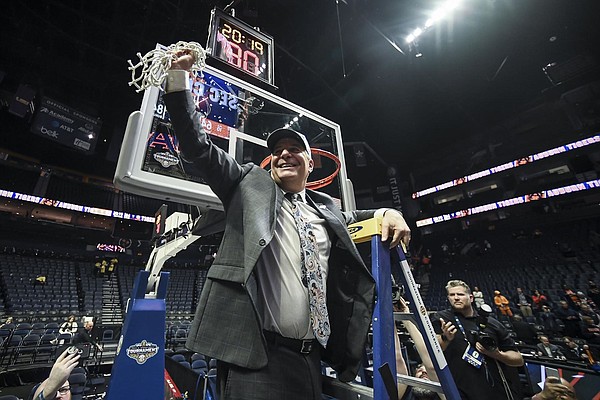B
Bama News

SEC basketball coaches OK with longer 3-point shot | Chattanooga Times Free Press
The Auburn Tigers led the NCAA this past season in men's basketball with 454 made 3-pointers and with 1,204 3-point attempts.
The Auburn Tigers led the NCAA this past season in men's basketball with 454 made 3-pointers and with 1,204 3-point attempts.
Kentucky, which was upset by Auburn in the Elite Eight of the NCAA tournament, ranked 316th nationally with 607 long-range tries.
Despite their drastically different methods of attack, Auburn coach Bruce Pearl and Kentucky counterpart John Calipari are both fine with the NCAA's decision earlier this month to extend the 3-point line from 20 feet, 9 inches, to 22 feet, 1.75 inches. The new distance mirrors what is used in international competition.
"I'm not a big proponent of shooting 40 3s, and if you are, your percentage is going to go down now," Calipari said Thursday during the annual Southeastern Conference summer teleconference. "I think it will make the game more about moving and spacing and open up the lane a little bit more. It will play out, but for young kids to say, 'That line has moved back, but we'll shoot the same percentage' — I just don't see that happening.
"I think percentages will come down, and now a coach is going to have to make the choice of shooting that many 3s or be more of a driving team."
The extended 3-point line was used on an experimental basis in this year's National Invitation Tournament, with teams in the NIT field actually attempting more 3s in the tournament per game (23.1) compared to their regular-season totals (22.8). The new length did have an effect on the accuracy, with the NIT teams making 33% of their long-range attempts after making 35.2% in the regular season.
NCAA Playing Rules Oversight Panel members approved the change after receiving positive feedback from coaches whose teams competed in the NIT.
"I wish the line had been farther back last year, because it would have helped us even more," Pearl said. "We had so many guys who could shoot and could shoot from great distances. I think it will be a positive thing for the game even though the percentages will go down a couple of points the first year.
"It won't affect your great shooters. It will affect your guys who don't shoot it very well, because they won't make as many, and they will take fewer."
When asked whether Auburn would attempt fewer long-range shots this upcoming season, Pearl said, "If we take fewer 3s, it will be because we lost some great 3-point shooters and not the effect of the line. We've always shot the 3 since it came into existence, and I don't see that changing much."
The NCAA last extended the 3-point line before the 2008-09 season, when the distance was moved from 19 feet, 9 inches. According to NCAA records, accuracy of 3-point shots that first year dipped from 35.2% to 34.4%.
Teams finally got back to 35.2% by the 2017-18 season.
"Initially, moving the 3-point line back will have an effect on shooting percentages," LSU coach Will Wade said, "but like anything, the players will adjust and everybody will adjust. As the season goes along, the 3-point percentages will go back up."
The NCAA panel earlier this month also approved resetting the shot clock at 20 seconds after a field-goal attempt hits the rim and is rebounded by the offensive team in the front court. The clock previously was reset to a full 30 seconds.
Calipari, Pearl and other SEC coaches Thursday seemed even more supportive of this change.
"Most of the time when you get an offensive rebound, you're going back up with it anyway," Wade said. "Maybe once or twice a game you pull it out, so I think it's a good thing for pace of play."
Said new Alabama coach Nate Oats: "We play fast, so anything to get more possessions in a game is something I'm up for. That will never affect us on offense."
Shining early
Second-year Georgia coach Tom Crean was asked Thursday about five-star freshman shooting guard Anthony Edwards. The 6-foot-5, 215-pounder from Atlanta was ranked No. 2 nationally on the 247Sports.com composite rankings in the 2019 class of recruits.
"I love his attitude," Crean said. "We vertical-jump tested the other day, and he jumped 42 inches. We do a bike-sprint test at the end of a full workout to see how quick you can go half of a mile on a stationary bike, and he did it in 50 seconds. Our strength coach said he had never seen anything like that.
"With that being said, we've got to get him better every day. He's got so much natural talent and natural strength, but there is a lot to learn, a lot to improve upon and a lot of new habits to create."

